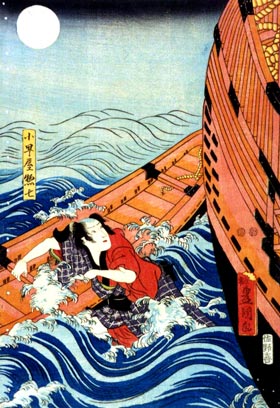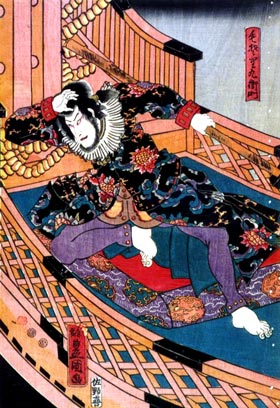| KEZORI |
| Play titles | Hakata Kojor˘ Nami Makura Yamato Kotoba Suikoden Koi Minato Hakata no Hitofushi |
| Authors | Chikamatsu Monzaemon ("Hakata Kojor˘ Nami Makura") Iso Isosuke ("Yamato Kotoba Suikoden") Namiki Gohŕ ("Keisei Hakata Ori") |
| History |
The story of "Kezori" is based on a real incident involving a gang of seven smugglers who were caught in Nagasaki and were nose-cutted and put in the stocks for three days in ďsaka in the 10th lunar month of 1718. Chikamatsu Monzaemon immediately adapted this event for the puppet theater, writing the drama "Hakata Kojor˘ Nami Makura", which was staged at the Takemotoza in the 11th lunar month of 1718. The Kabuki had to wait up to the 7th lunar month of 1776, with the production at the Kado no Shibai of Iso Isosuke's drama "Yamato Kotoba Suikoden" [more details]. Namiki Gohei wrote another version, which was entitled "Keisei Hakata Ori" and was staged for the first time in the 1st lunar month of 1778 in Ky˘to at the Minamigawa no Shibai [casting | picture and details]. "Keisei Hakata Ori" was revived several times in Kamigata and revised by Namiki Sh˘z˘ II. Kezori's story was staged under the title "Koi Minato Hakata no Hitofushi" for the first time in the 8th lunar month of 1840 at the Nakamuraza [casting]. This title is still used nowadays and "Kezori" can be produced either as "Hakata Kojor˘ Nami Makura" or "Koi Minato Hakata no Hitofushi". The role of Kezori Kuemon, a larger-than-life smuggler, became one of the favourite roles of the star Ichikawa Ebiz˘ V (Danjűr˘ VII), who performed it many times and helped to its transmision to his line. His son Ichikawa Danjűr˘ IX created the famous shiomi no mie, the highlight of this great play. Nowadays, the role of Kezori is an atariyaku for Ichikawa Danjűr˘ XII. |
| Structure |
The original drama was in 3 acts. Nowadays, a common production of "Kezori" is made up of 2 acts and 4 scenes, the act on Kezori's boat and the act at the Okudaya brothel. The last act, which is about the tribulations of S˘shichi, his return to his father's home and his death, is occasionally revived. |
| Key words | Sewamono Shiomi no Mie |
| Summary |
Act I: a smugglers' boat off Shimonoseki As the curtain opens, the drop curtain blocks the view, and nothing can be seen behind it. After some time of anticipation, the drop curtain falls with the sharp strike of wooden clappers. What the audience faces is a huge boat taking up much of the stage space. This arrangement created quite an effect in showing the fine setting of the stage. Surrounding the boat is the mighty ocean. A cloth with a wave design (naminuno) covers the whole stage and extends up the ramp stage. The boat heading to the Port of Hakata is now off the coast of Shimonoseki. A drinking spree starts among boatmen and Kezori Kuemon. Kezori with a Nagasaki accent and red wavy hair, appears suspicious holding a glass. A passenger, Komatsuya S˘shichi, a merchant from Ky˘to, begins drinking with them. S˘shichi is on his way to see his love, Kojor˘, a courtesan of the Hakata Yanagimachi quarter, under the pretext of a business trip. S˘shichi, preoccupied with the thought of the tryst, could in no way tell the real identity of Kezori. Deep into the night, when everybody is fast asleep, a flat-bottomed barge full of exotic articles pulls up next to the boat. The boat was a smuggling boat run by the Kezori gang. Unluckily for S˘shichi, who witnesses the smuggling, he is thrown into the ocean. After a while, the boat slowly turns from a side view to a position with the bow in front. Standing on the bow is Kezori in exotic ezo brocade clothing, who thrusts his hands forward and then to the side in big circle to strike the mie pose with a ferocious glare. This is known as shiomi no mie, marking the end of the first act. Then, in front of the closed curtain, appears a small boat, gliding on the cloth wave of the ramp stage, and on board is S˘shichi who barely escaped his death. With a vow to revenge Kezori, S˘shichi disappears into the draw curtain at the far end with the audience included in the scene as part of the ocean. Act II: the Okudaya brothel in Yanagimachi, Hakata The second act unfolds in Okudaya in Yanagimachi quarter. It conveys the feeling of a red light district of a rural city, different from the ones in big cities such as Shimabara of Ky˘to or Yoshiwara of Edo. S˘shichi, arriving in rags to see Kojor˘, runs into Kezori. He is forced to become a member of the smuggling gang in order to save his life. But the events leading to this deserve some attention. With the revolving stage, the drawing room of Okudaya turns to reveal a scene in which Kojor˘ is combing and fixing S˘shichi's hair implying that their coupling is over. It might seem insignificant, but the inclusion of this scene makes a difference in the interpretation of the following scenes. As mentioned earlier, upon his encounter with Kezori, S˘shichi is forced to choose death or join the gang. Seeing S˘shichi irresolute, Kojor˘ puts her hand under S˘shichi's clothing to wipe sweat off of his chest. Kojor˘, not as apprehensive, is merely implying that she will stay with him even through hell. Returning to him is the sensation of their intimacy. Thus, a woman's rationale wins over justice. Iwai Masami (original ) |
 |
 |
|
The actors Ichimura Uzaemon XII and Ichikawa Danjűr˘ VIII playing the roles of S˘shichi and Kezori Kuemon in the drama "Mimasu Dokko Hakata no Uchikake", which was staged in the 1st lunar month of 1848 at the Ichimuraza (print made by Utagawa Toyokuni III) |
|
|
|
| Contact | Main | Top | Updates | Actors | Plays | Playwrights | Programs | Links | FAQ | Glossary | Chronology | Illustrations | Prints | Characters | Derivatives | Theaters | Coming soon | News |